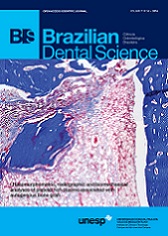Evaluation of the Location of Mandibular Foramen as an Anatomic Landmark Using CBCT Images: A Pioneering Study in an Iranian Population
DOI:
https://doi.org/10.14295/bds.2014.v17i4.1006Abstract
Objective: Mandibular foramen (MF) is located on the internal surface of the ramus through which blood vessels and nerves pass. Determination of the anatomic position of the MF is very important in inferior alveolar nerve block anesthesia (IANBA), ramus osteotomy and surgical procedures of the posterior angle of mandibular ramus. The aim of this study was to determine anatomic position of the MF using anatomic landmarks on the three dimensional CBCT images. Material and Methods: A total of 103 CBCT images was evaluated. The NNT Viewer software program was used to measure the distances between the lines tangent on the MF periphery and the anterior border of the ramus, the posterior border of the ramus, the inferior border of the mandible, and the coronoid notch in mm by to age and gender. Results: The results showed a slight difference in anatomic dimensions between the right and left sides, with no significant differences. The anatomic dimensions of the MF on both sides were a little bigger in males than in females. There were no significant differences in the anatomic dimensions of superior-inferior and anterior-posterior dimensions of the left and right sides in different age groups. Conclusion: No significant changes occur in the position of the MF with age. The anatomic differences between males and females should be taken into account during IANBA procedures. Males have bigger jaws than females; therefore, there is a longer distance between the MF and the anatomic landmarks evaluated.
Keywords: Mandibular Foramen; Anatomic Landmarks; Cone-Beam Computed Tomography
Downloads
Downloads
Additional Files
Published
How to Cite
Issue
Section
License
Brazilian Dental Science uses the Creative Commons (CC-BY 4.0) license, thus preserving the integrity of articles in an open access environment. The journal allows the author to retain publishing rights without restrictions.
=================




























